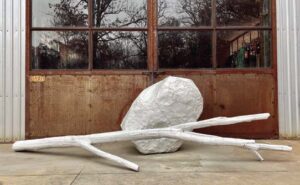
Cutting through time
By Jim Dodson
Save for a handsaw, an old pocket wallet and quiet memories, they are all that I have left of him.
The wallet is a fine piece of work, a gentleman’s pebble grain leather breast wallet, beautifully stitched and bearing my grandfather’s initials in gilt lettering: W.W.D.
William Walter Dodson was a skilled carpenter and electrician who helped raise this region’s first electrical transmission towers and worked on the crew that wired Greensboro’s Jefferson Standard Building. During the Second World War, he also made cabinets for PT boats and built bookshelves for local public libraries.
The wallet is in mint condition, lined with fine silk, its state of preservation suggesting it was scarcely used. I think my dad brought it to my grandfather upon returning from military service in England and Normandy, in 1945. My guess is, Walter rarely used it because he was a workingman who rarely, if ever, dressed up. As I remember him, he was a preternaturally quiet but gentle man in rumpled cotton pants who was either fishing or in his woodshop or massive vegetable garden — the three places I spent most of my time with him. There was always the stump of a King Edward cigar in his mouth.
Walter’s handsaw, on the other hand, shows years of steady use, well worn and rusted in places near its simple wooden handle. I suppose it must be 80 years old if a day.
Both wallet and saw came my way decades ago and traveled with me to Georgia and Maine and back to Carolina in order to complete the sacred circle old elephants and most Southerners observe before they translate to a gentler, kinder place.
I inherited the items from my father, who never used the wallet either — too nice, he claimed — but did use that old handsaw for years until power saws showed up in his own woodworking workshop. He made bookshelves and tables for friends and family.
Not surprisingly, I picked up the woodworking bug too, clearly something in the bloodline. We hail, after all, from a long line of Carolina woodworkers, at least one of whom was a celebrated cabinetmaker.
Walter’s grandfather — my great-great-granddad — was one George Washington Tate, a prominent citizen of Alamance County who helped survey the boundaries of the state’s central counties following the Civil War, but was best known for his grist mill on the Haw River and his skill at crafting fine furniture.
Last summer, while attending a seminar at the Museum of Early Decorative Art (commonly known as MESDA) on the Scots-Irish furniture makers who filtered into the Carolina back country during the 18th century, I heard G.W. Tate’s name mentioned in a tone of near reverence by an expert on Piedmont furniture making, who noted that one of his most notable surviving pieces is a handmade wardrobe displayed in a Williamburg museum of early American furniture. Tate Street in Greensboro is named for this man.
She was delighted when I informed her afterwards that I knew of a second splendid handwork of Tate’s. My second cousin Roger Dodson and his wife, Polly, had recently had us to supper and showed us a handsome old walnut corner cupboard that bore his distinctive mark “G.W. Tate.”
It was his grandson Walter, however, for whom I’m partially named, who first placed a saw in my hand. One Christmas when I was about 6 or 7 years of age, visiting my grandparents in Florida, he gave me a miniature tool box with a small hammer, screw drivers and handsaw.
In his modest workshop, he also showed me how to saw a straight line and hammer a nail — small tasks that seemed almost magical at the time.
Somehow that kid’s toolbox disappeared over the years, probably because I used its tools constantly to build forts in the woods around our house. I recall using them to build my entry for the annual Cub Scout Pinewood Derby. My car got eliminated early, which was perfectly fine with me. I much preferred building forts and crude furniture.
It wasn’t until I was over 30 and living on the coast of Maine that two abiding passions hit me with a vengeance, both of which I trace to a quiet carpenter and gardener in rumpled pants.
The first struck when my wife and I built a post and beam house on a forested hill in Maine. I helped the housewrights place the structural beams, but did most of the interior finish work myself, learning as I went.
Not only did I lay and peg the 16-inch ancient pine flooring boards salvaged from a 19th-century barn in New Hampshire, I also designed and built the kitchen’s counter and cabinetry from scratch. Ditto the adjoining walls of pine bookshelves in the living room. My distinctly Southern mama, when she first walked into our home, smiled and remarked, “Honey, all this wood is very pretty. But when are you going to finish this house?”
The Canadian hemlock beams and pine floors and cabinets cast a golden glow over everything, especially as the sun shone through our tall south-facing windows. Over nearly two decades that followed, I loved the subtle creaks and moans the beams and floors made as the house settled and the wood aged, especially in the dead of winter when the sun struck the beams and the house emitted out a lovely scent of the forest. I thought of this as the house exhaling in a contented way that my late grandfather would likely have approved.
Walter probably would have liked the rustic farm table and occasional table I made for the living room, too. The table we gave away when my second wife and I moved home to North Carolina. The occasional table went to my first wife’s house, where it’s still in use and quite loved today.
Walter Dodson passed on when he was 64. I was 11, my first funeral, and it was really sad to see him go. He looked remarkably peaceful in his big wooden coffin, dressed in the only suit I ever saw him wear. My grandmother was a serious Southern Baptist, though Walter rarely darkened the doorway of any church. Time on the water or in his workshop or garden were his idea of worship, his way celebrating the gift of life. Anyone who works intimately with wood or tends a garden through the seasons would completely understand.
As I write, this Walter is also 64 years old and preparing to build a set of ambitious bookshelves for the cozy room my wife and I have decided would make a splendid library in the old house we’ve been slowly redoing over the past 20 or so months.
I have my eye on a fancy new power saw that will do just about anything from the finest trim work to cutting a rough plank flooring. It costs more than my gifted, gentle grandfather probably made in a year.
Proof that you can take the boy out of the woodshop but not the other way around, however, resides in the fact that Walter’s handsaw will be hung somewhere in my new woodshop where those bookshelves will be born, a sweet reminder that the hand that shapes the cut was created long before the saw ever touched wood.
Contact Editor Jim Dodson at jim@thepilot.com.





